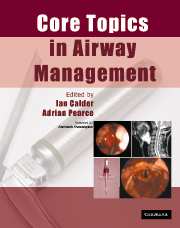Book contents
- Frontmatter
- Contents
- List of contributors
- Preface
- Acknowledgements
- List of abbreviations
- 1 Anatomy
- 2 Physiology of apnoea and hypoxia
- 3 Physics and physiology
- 4 Cleaning and disinfection of airway equipment
- 5 General principles
- 6 Maintenance of the airway during anaesthesia: supra-glottic devices
- 7 Tracheal tubes
- 8 Tracheal intubation of the adult patient
- 9 Confirmation of tracheal intubation
- 10 Extubation
- 11 Light-guided intubation: the trachlight
- 12 Fibreoptic intubation
- 13 Retrograde intubation
- 14 Endobronchial and double-lumen tubes, bronchial blockers
- 15 ‘Difficult airways’: causation and prediction
- 16 The paediatric airway
- 17 Obstructive sleep apnoea and anaesthesia
- 18 The airway in cervical trauma
- 19 The airway in cervical spine disease and surgery
- 20 The aspiration problem
- 21 The lost airway
- 22 Trauma to the airway
- 23 Airway mortality associated with anaesthesia and medico-legal aspects
- 24 ENT and maxillofacial surgery
- 25 Airway management in the ICU
- 26 The airway in obstetrics
- Index
18 - The airway in cervical trauma
Published online by Cambridge University Press: 15 December 2009
- Frontmatter
- Contents
- List of contributors
- Preface
- Acknowledgements
- List of abbreviations
- 1 Anatomy
- 2 Physiology of apnoea and hypoxia
- 3 Physics and physiology
- 4 Cleaning and disinfection of airway equipment
- 5 General principles
- 6 Maintenance of the airway during anaesthesia: supra-glottic devices
- 7 Tracheal tubes
- 8 Tracheal intubation of the adult patient
- 9 Confirmation of tracheal intubation
- 10 Extubation
- 11 Light-guided intubation: the trachlight
- 12 Fibreoptic intubation
- 13 Retrograde intubation
- 14 Endobronchial and double-lumen tubes, bronchial blockers
- 15 ‘Difficult airways’: causation and prediction
- 16 The paediatric airway
- 17 Obstructive sleep apnoea and anaesthesia
- 18 The airway in cervical trauma
- 19 The airway in cervical spine disease and surgery
- 20 The aspiration problem
- 21 The lost airway
- 22 Trauma to the airway
- 23 Airway mortality associated with anaesthesia and medico-legal aspects
- 24 ENT and maxillofacial surgery
- 25 Airway management in the ICU
- 26 The airway in obstetrics
- Index
Summary
Introduction
Acute victims often require immediate tracheal intubation and when this is necessary there are a number of concurrent problems to consider. There may or may not be immediate airway obstruction caused by extensive disruption to normal airway anatomy from both blunt and penetrating injuries. Airway haematoma and oedema may be present and certain injury patterns are recognized as causing airway compromise including the ‘flail’ mandible, where loss of support for the tongue anteriorly encourages it to fall backwards. Additionally, there may be severe haemorrhage and other debris present in the airway, which can make fibre-optic techniques impractical. There is invariably a full stomach with the associated risk of aspiration and finally, one must always consider injuries to the cervical spine.
Cervical spine injury
Approximately, 5% of severe, blunt injuries to the head and neck have cervical spine damage. Up to 14% of these injuries may be unstable, and between 1% and 5% of these injuries are initially missed. Fractures most commonly occur at the level of C2 and dislocations at the C5/6/7 regions (Figure 18.1). All such injuries may predispose to further airway obstruction from haematoma formation and soft tissue oedema in the neck (Table 18.1). Sadly, about 5% of patients admitted to hospital with cervical spine trauma will suffer a neurological deterioration after admission. Some of these deteriorations occur for no discernible reason, but some are associated with general anaesthesia. It seems sensible, therefore, to assume that there is an un-quantified risk of neurological deterioration in patients undergoing general anaesthesia with cervical spine injuries.
- Type
- Chapter
- Information
- Core Topics in Airway Management , pp. 139 - 146Publisher: Cambridge University PressPrint publication year: 2005
- 1
- Cited by



